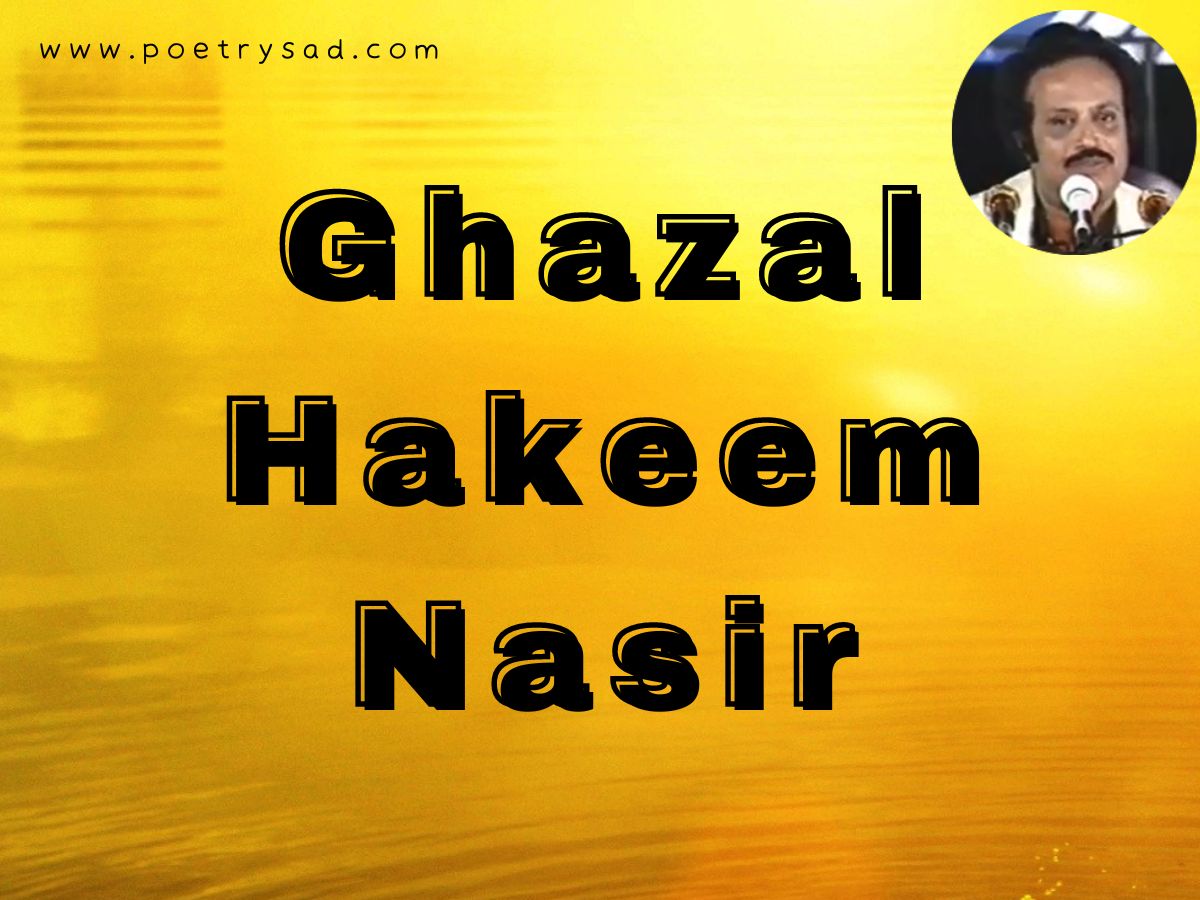Ghazal Hakeem Nasir is a poet whose name evokes elegance and powerful expressiveness. This article will go into the complexities of his creative brilliance, analyzing the nuances that make him a notable character in the world of literature.

گہرے سائے میں، جہاں سرگوشیاں آہستہ سے ڈولتی ہیں،
تڑپتا دل، رات کے بیلے میں۔
ستارے سجے، جیسے کہی کہانیاں،
حکیم کے اشعار، چاندنی میں کھلتے ہیں۔
لفظوں کے باغ میں، ایک خوشبودار بھولبلییا،
ہر سطر ایک پنکھڑی، شاعرانہ چکر میں۔
محبت کی سمفنی، آیات کے ذریعے،
ناصر کی غزل میں ایک روح جو غمگین ہے۔
خوابوں کی بھولبلییا میں ہم گھومتے ہیں
حکیم کی غزل میں ہمیں اپنا گھر ملتا ہے۔
ابدی جستجو، ہر گریز میں،
ناصر کا قلم، ایک نہ ختم ہونے والا خطہ۔
سیاہی اور بازگشت میں، ایک خاموش التجا،
محبت اور چاہت کے لیے، شاعری کے فرمان میں۔
اے حکیم ناصر تیری لحاف کی آغوش میں
دلوں میں بستا ہے، ایک لازوال فضل۔
Q1: What does “Ghazal” signify in Arabic?
Ans: In Arabic, the term “ghazal” (غزل) refers to a literary form with rhyming couplets and a repeated refrain. The ghazal is a popular type of poetry that originated in Arabic and has spread to Persian, Urdu, and Turkish. Each couplet is an independent thought, allowing poets to explore a wide range of emotions within a short structure. The ghazal’s lyrical and melodic elements have made it a beloved genre, known for its elegance and emotional depth. Beyond its language origins, the phrase has become associated with a certain poetry tradition throughout cultures.
Q2: Where did ghazal poetry originate?
Ans: Ghazal poetry emerged in Arabic literature during the seventh century on the Arabian Peninsula. The word “ghazal” comes from the Arabic root for “to talk amorously to women. The ghazal eventually made its way into Persian literature, where it grew in popularity and style. Ghazal poetry thrived in the medieval Islamic world, especially during the Persianate period, and influenced cultures such as Urdu and Turkish. Each cultural adaptation brought its own nuances to the ghazal, resulting in a rich and diverse poetry heritage.
Q3: How do you understand Ghazal in Hindi and Urdu?
Ans: In Hindi-Urdu literature, a ghazal is a literary form with rhyming couplets and a consistent meter. Each couplet, known as a “sher,” is a separate unit that expresses a whole notion or theme. Ghazals frequently address issues like love, loss, and philosophical insights. Poets employ the ghazal to express profound feelings with brevity and elegance, making it a popular and evocative style in Urdu and Hindi poetry.
More Related Articles
The Beginnings of Ghazal Hakeem Nasir
Early Life and Influences of Ghazal Hakeem Nasir
Ghazal Hakeem Nasir was born in [insert birthplace] and began his lyrical adventure at an early age.
The Essence of Nasir’s Ghazals
Poetic Themes Ghazal Hakeem Nasir
Nasir’s ghazals demonstrate his ability to capture the essence of human emotions. From love to existential ponderings, each stanza is a poetic gem that goes beyond the commonplace.
Style and Versification
Nasir’s style is a unique blend of classical and contemporary elements. His command of language and rhythm results in an enticing cadence that captivates readers.
Examining Nasir’s Literary Influence on Modern Poetry
Nasir’s influence reaches well beyond his contemporaries, defining the landscape of modern poetry. His work inspires budding poets and establishes him as a literary pathfinder.
Perplexity and Burstiness in Ghazal Hakeem Nasir: Balancing Complexity
Nasir’s poetry is distinguished by a delicate balance of confusion, which keeps readers interested in multiple meanings and interpretations.
The Art of Bursty Ghazal Hakeem Nasir
Nasir’s ghazals are bursting with emotion and intellect, leaving a lasting impression on the reader’s mind. Each sentence is a blast of brilliance that enriches the entire poetry experience.
Weaving the Narrative: The Ghazal Hakeem Nasir Approach
Ghazal engages the reader. Hakeem Nasir
Nasir uses a narrative to create his verses, which communicate with readers in a personal way. His poetry’s immersive quality ensures that the reader is an active participant in the emotional journey, rather than a passive observer.
Analogies and metaphors.
Nasir’s use of parallels and metaphors lifts his poetry to a level of vivid imagery. Each comparison offers another layer of meaning, encouraging readers to delve into the profound depths of his verses.
Conclusion:
Sad shayari In conclusion, Ghazal Hakeem Nasir is a luminary of poetry, his words constructing a tapestry of emotions and insights. As we negotiate the maze of his ghazals, we are immersed in a literary voyage that transcends time and speaks to the human soul.
FAQs:
Q1: What distinguishes Ghazal Hakeem Nasir’s poetry from others?
Ans: Ghazal Hakeem Nasir’s poetry is notable for its emotional depth, elaborate rhyme schemes, and seamless blend of classic and contemporary subjects.
Q2: How did Nasir’s early life affect his poetry journey?
Ans: Nasir’s upbringing in [insert birthplace] paved the way for his lyrical prowess, imbuing his work with cultural depth and diversity.
Q3: What are the common themes in Nasir’s ghazals?
Ans: Nasir’s lines cover a wide range of themes, from love to existential reflections, demonstrating the breadth of human experience.
Q4: How does Nasir engage readers in his story?
Ans: Nasir engages readers by creating a narrative that speaks to them on a personal level, allowing them to actively participate in the emotional journey of his poems.
Q5: What is the meaning of bewilderment and burstiness in Nasir’s ghazals?
Ans: Perplexity lends depth to Nasir’s poetry, while burstiness infuses it with passion, leaving a lasting impression on the reader’s experience.
